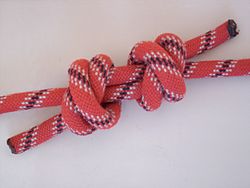Double spar stitch
| Double spar stitch | |
|---|---|

|
|
| Type | connection |
| application | connect two ropes securely |
| Ashley No. | 1415 |
| Synonyms | Double fishing knot, double fishing knot |
| English | Double Fischerman's knot, Grapevine knot, Double English knot |
| List of nodes | |
The double spar stitch is a knot for securely connecting two ropes.
application
The double spar stitch is used in alpine sports to connect two ropes. The teardrop shape is recommended for abseiling, as the knot slips better through the snap hook and is less likely to get stuck in crevices in the rock. The knot strength of the double spar stitch is much better than that of the single spar stitch ; the triple spar stitch is again significantly better than the double.
Knot
Line shape
Two ends of the rope are placed on top of each other in opposite directions. With one end of the rope, a double overhand knot is tied around the other . With the other end of the rope, a second double overhand knot is tied over the long end of one rope. Both knots are carefully tightened and pushed together by pulling on the long ends.
Teardrop shape
Two rope ends are taken in parallel. With one end of the rope, a double overhand knot is tied around the other . With the other end of the rope, a second double overhand knot is tied over the short end of one rope. Both knots are carefully tightened and pushed together by pulling on the long ends.
Alternatives
- The simple spar stitch is easier to knot , but it doesn't last as well.
- The pocket stitch in the form of a teardrop is even easier .
- The schotstek or the double schotstek is used in shipping .
- Ribbon loops are connected to the ribbon loop knot .
Modifications
- If a single overhand knot is tied instead of the double overhand knot , the result is a simple spar stitch .
- If two ropes are taken in parallel and first an overhand knot is tied with the first rope around the second, then another overhand knot with the second around the first and finally a third overhand knot with the first rope around the second, a triple T-regular lay (previously Triple T-bar stitch).
- If a single double overhand knot is tied around the fixed end, the cave knot is created . This is a tightening noose.
- Anglers use the double grinner knot to tie two fishing lines together.
See also
Web links
Individual evidence
- ↑ Investigation at the DAV and http://www.gudelius.de/spst.htm










